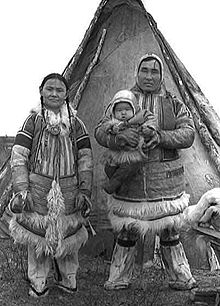Nganasans
The Nganasans are the northernmost people of Eurasia . They live north of the Arctic Circle in the area of the Taimyr Peninsula (in the northern part of the North Siberian lowlands ), in the Krasnoyarsk region ( Russia ).
In the Russian Empire the Nganasans were known as tawgijzy ( тавгийцы ). The ethnonym Nganasanen goes back to the Russian linguist and ethnographer GN Prokowjew, who derived it from the Nganasan word nganasa ("man", "human being"). The Nganasans themselves do not use this name. Men are referred to with the word nja-nganasa , women with nja-ny and the people with nja-tansa .
The Nganasans are a Samoyed people of the Ural family, they belong to the Northern Samoyed , along with the Nenets and Enzen . Their language, the critically endangered Nganasan , is a Samoyed language related to Nentish and Enzish . According to the last population census, the number of Nganasans tends to reach 900, of which 83 percent of those surveyed named Nganasan as their mother tongue. The Nganasans divided into two groups: the western (awamische Nganasans with centers in Dudinka and in villages Ust-Awam , Wolotschanka ) and eastern (wadeische Nganasans with the center in the village of Novaya). The Awamian Nganasans are divided into five and the Wadish into seven tribes, although the Awamian Nganasans represent a much larger group (approx. 80 percent).
In the 18th century the Nganasans were subjugated by the Russians and gradually Christianized. In many places, however, Christian ideas mixed with traditional belief in nature. Since the 19th century, the Nganasans lived off reindeer herding as shepherd nomads, but originally they were exclusively hunters and fishermen. Since the 17th century, the people of the Yakuts , Dolgans and Nenets were displaced from some of their original habitats.
At the end of the 20th century, the Nganasans have almost completely given up their traditional way of life and now live sedentary in small towns and hunting villages. The regional radio regularly broadcasts programs in Nganasan, and articles in the newspaper are printed in this language. The wild exploitative subsistence economy but is since the collapse of the Soviet Union - linked to a renewed rise in isolation - as the primary protein source.
Origin and relationship
The Nganasans is the traditional view to samojedisierte descendants of Tungusic tribes of the Evenki (Pjasinskaja Samoyed, Kuraken, Tidirisen, Tawgen and others).
Nation and language were not finally formed until the end of the 17th century. Even today the language shows very many similarities with the neighboring languages Selkupisch and Jukagirisch .
Recent studies show that parts of the eastern Fennoscan Saami show genetic influences from immigration by the Nganasans. This component first appears around 1500 BC. On the Kola Peninsula (Bolshoy Oleni Ostrov in the Murmansk region). The study suggests that there were apparently longer interactions between Nganasan groups and the Saami population, which at that time also lived further south. In older samples, the Nganasanen genetics were completely missing in Fennoscandinavia, so that a founder effect can be assumed in the beginning of the Iron Age. This also coincides with the beginning of the reindeer industry. Proportions of this nganasan component can also be found in the Finnish, Karelian and East Baltic populations.
Based on the results, the formation of the Nganasans as residents of the Taimyr Peninsula and the northern Urals region (Samoyed) is at least 1500 BC. To apply.
Belief and religion
Shamanistic practices from the original ethnic religion are still widespread. Apart from the shaman's drum , no traditional musical instruments are known. In addition, like the Nenets, the Nganasans have a strict Russian Orthodox orientation, combined with a strong Christian spirituality .
literature
- Chester S. Chard: The Nganasan: Wild Reindeer Hunters of the Taimyr Peninsula. In: Arctic Anthropology, Vol. 1, No. 2. 1963, pp. 105-121.
Individual evidence
- ↑ В.А. Тураев, Р.В Суляндзига, П. В. Суляндзига, В.Н. Бочарников: Энцыклопедия коренных, малочисленных народов Севера, Сибири и Дальнего Вкостока РоссийВостока . Москва 2005, p. 143.
- ^ Department of Economic and Social Affairs: State of the World's Indigenous Peoples . In: un.org, publication ST / ESA / 328, 2009, accessed on January 22, 2020. p. 18.
- ↑ Lamnidis et all 2018, Ancient Fennoscandian genomes reveal origin and spread of Siberian ancestry in Europe, DOI 10.1038 / s41467-018-07483-5
- ↑ Chester S. Chard, p. 114.
